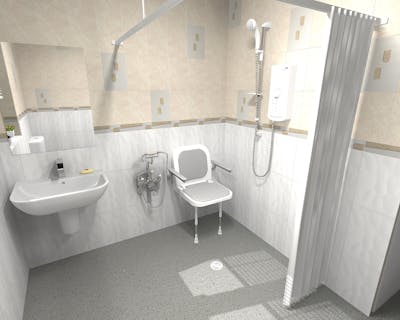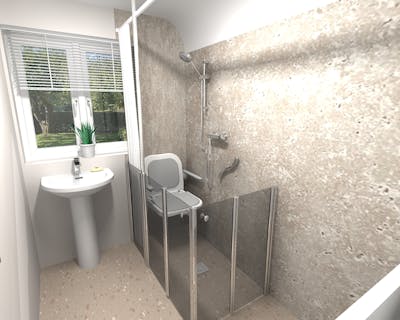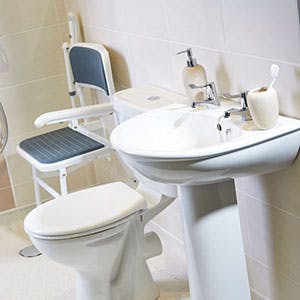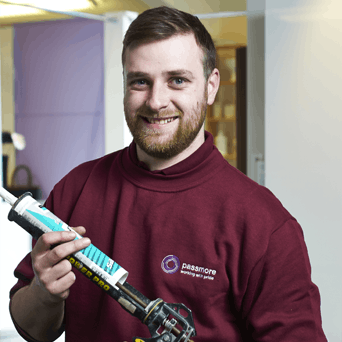Dementia-friendly bathroom design: A comprehensive guide to creating a safe, accessible, and comfortable space
Published: 4 February 2019 · Last Updated: 6 December 2023
In the UK, we have an ageing population. That also comes with its challenges, one of them being dementia. Dementia typically affects those of the older generation, usually 65 years and older. It is reported that in the UK there are around 850,000 people with dementia.
So with just under 1 million people with dementia in the UK, you can imagine it has an impact on their day-to-day living. We are going to delve into the areas it affects and the impact it has on your daily activities, then lastly we’ll look at how we can improve the daily lives of those with dementia in the bathroom.
What is dementia?
Dementia is a syndrome associated with an ongoing decline of the brain and its ability to function. A relatively common condition, the risk of developing dementia increases with age, and some of the areas it affects include:
> Affected memory
> Mental agility
> Cognitive decline
> Loss of motor skills
These are some of the few impacts that dementia has alongside a reduced independence and the ability to carry out tasks to completion.
Impact it can have on activities?
Dementia can affect the ability to carry out day-to-day activities, which can make a person’s life difficult in several areas.
Individuals with dementia often have a lower perception of awareness and danger which could prove to be challenging for them and cause concern for their safety.
Memory can also be affected by dementia, leading to shortened recollection and potentially not being able to remember tasks.
Similarly, personal care could pose a problem with dementia as it progresses, either forgetting about it or struggling with hygiene maintenance.
These are just a few activities that can be affected by dementia.
Dementia-friendly bathroom design
If there is a person within a household who has dementia, then it is necessary to install dementia-friendly features throughout the home, to ensure their safety, prevent accidents from occurring, and to help retain their independence.
By doing so, you’re truly providing the family and the user with peace of mind. They’d be less worried with all the dementia-friendly features that would’ve been installed.
As leading experts in delivering a range of bathroom adaptations, we provide those with dementia-adapted bathroom/shower room designs, including accessible, mobility, and disabled bathrooms, throughout Yorkshire. To ensure that their needs and requirements are met, and most importantly their safety is retained as well as, if possible, their independence.
So you could be wondering how you create a dementia-friendly bathroom or an adapted bathroom that suits those with dementia.
We have broken down key elements for creating a dementia-friendly bathroom, In this guide, you will find ideas, and considerations to create a safe, accessible, and comfortable bathroom design for an individual with dementia.
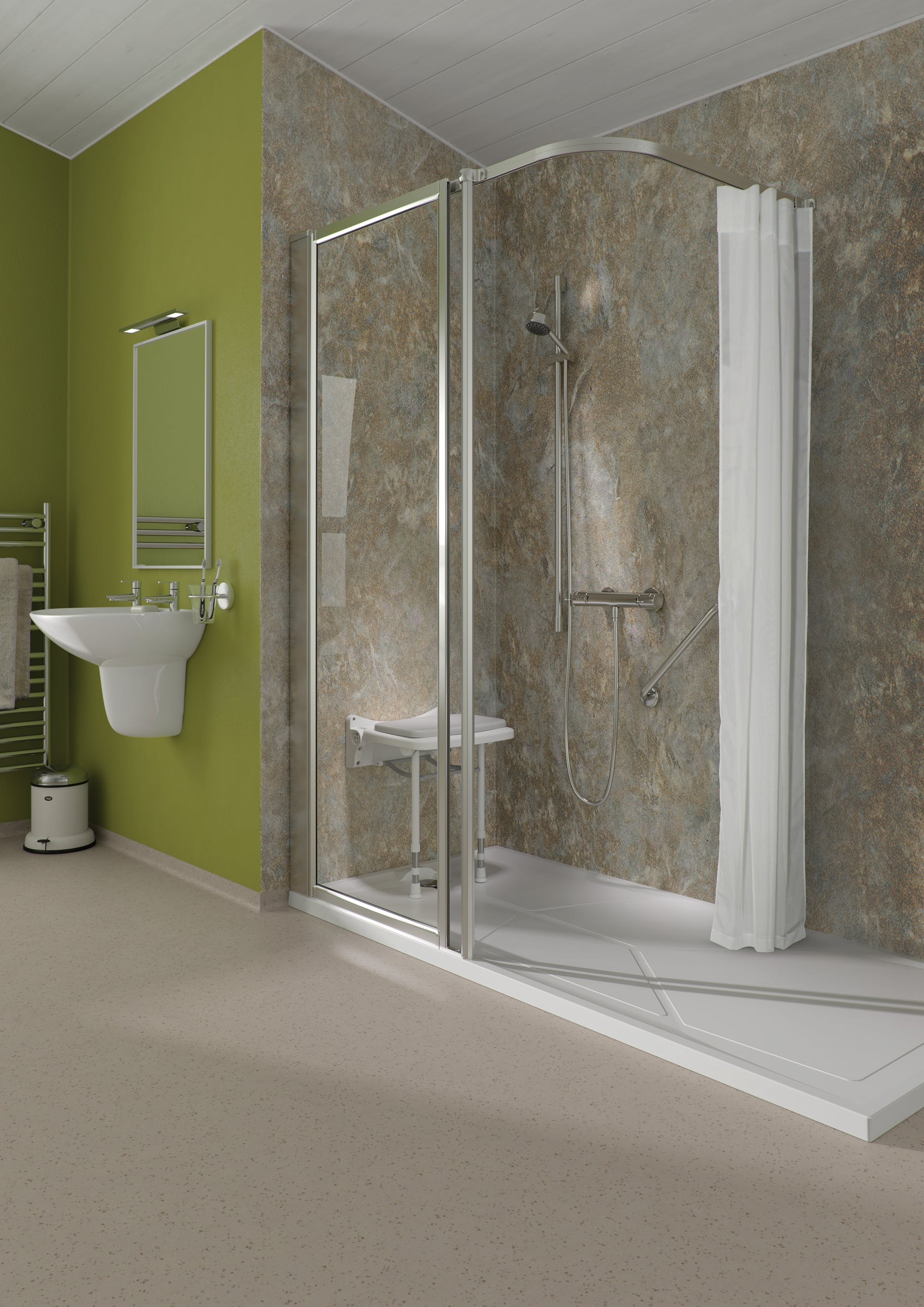
Safety
Fall prevention
We briefly mentioned dementia can affect many areas of a person’s day-to-day life and if it progresses to a point where it is now affecting their motor skills, fitting non-slip flooring could be one of the first factors you consider in a refurbishment of a bathroom into a dementia-friendly design.
Non-slip flooring, or anti-slip vinyl flooring known to others, is the safest flooring option in general for bathroom designs.
Confidence can be increased hugely especially for those who struggle with walking, balance, and coordination. Non-slip flooring prevents falls from occurring, especially with bathrooms prone to becoming slippery and wet increasing the chances of a fall.
One of the more popular bathroom designs is a level access solution, preferably a disabled wet room. This design means that the whole concept will fit with the anti-slip vinyl flooring, including the shower area, where the risk of falls is usually at its greatest.
An added benefit of non-slip flooring is that it is considered cost-effective due to its longevity and ease of maintenance.
Continuing with the presentation of a fall happening in a dementia-friendly bathroom, the concept reflects the installation of grab bars close to the toilet, shower, and bathtub.
Grab bars are designed to help keep the users balanced in the design and install them close to the main fixtures of a bathroom, giving them enhanced stability, whether they’re entering, standing up, or requiring assistance when manoeuvring around the bath concept.
The good thing about grab bars is that you can install as many as you need in the bathroom design.
Overall, grab bars with these features promote retention of independence within the bath space.
Lastly, simply removing clutter and potential trip hazards in the bathroom, is essential for the safety of the user, as they will be able to navigate around the bathroom space with a clear path and not have to worry as much that they could trip or fall.
It also helps to keep the dementia-friendly bathroom organised.

Prevent burns and scalds
Dementia users could have trouble sensing and responding to the water temperatures and being able to adjust the faucets.
Installing thermostatic mixing valves, also known as TMV, could be a game changer as they’re preset to a water temperature that is safe and comfortable to use. This bathroom feature promotes a user-friendly dementia bathroom design and just like the ideas we mentioned in this blog, increases their level of confidence and, most importantly, peace of mind with independence retained.
Reduce confusion and anxiety
Clear signs and labels in dementia-friendly bathroom design are important. Confusion can occur in those with dementia and preventing that with clear signs and labels of the bathroom features like a sink, and toilet, aids their visual and recognition function. This minimises the potential frustration taking place.
Others with dementia could have problems communicating or expressing their needs, and the signage around the dementia-friendly bathroom design helps them as they will be able to communicate with caregivers and individuals giving them visual cues of their needs.
Further reducing confusion in a dementia-friendly bathroom is consistent contrasting colour patterns throughout. Dementia can affect the visualisation of how well someone can recognise colours. We advise that having diverse colour codes for different areas, will help the user distinguish all the different elements of the bathroom space. An example is to have the shower seat and grab bars a different colour to the wall and floor.
Having this breeds familiarity and recognition and will allow them to be comfortable and improve their overall daily life.
In a dementia-friendly home, avoid reflective surfaces, as they can be visually distracting, and can even lead to confusion or distress with a wrongly perceived perception.
Accessibility
Ensure easy access to all areas of the bathroom
We now move on to how we can make the lives of those with dementia, easier with the ease of access to their bath or shower room space.
Widening the doors can play a crucial role in creating a dementia-friendly bathroom environment. It will facilitate those with dementia and mobility challenges who potentially have aids like wheelchairs or walkers with easy access to their bath concept, reducing the risk of an accident.
You also give them space and the ability to manage themselves around, this especially helps the users who have difficulty with their surroundings.
This also helps the carers as they will be able to aid those who need extra support much easier to navigate into the room.
This could be of interest and useful. However, if you ever are unsure whether widening the door is something that you should do, we recommend contacting a consultant or experts, such as ourselves, who can further advise or design a fully project-managed dementia-friendly bathroom with a widened door if the needs require it.
Expanding the ease of access to the bathroom in all areas the bathroom is to have a walk-in shower or a bathtub installation that could include a seat.
These bathroom feature designs are a perfect fit for a bathroom-friendly design, for several reasons.
Typically, with a walk-in shower or accessible wet floor shower design, you have reduced steps or it is a level access making entry for dementia users much easier, hugely minimising the risk of them falling.
Let’s take for instance that there is a seat that is fit for them, boosting their overall showering experience through comfort and super beneficial for those who experience fatigue.
On the other hand, a bathtub installation is a possible consideration for a dementia-friendly bathroom, that is because this will depend on the individual's varying needs. This could be because the individual has a
disability or limited
mobility, a
walk-in bathtub would alleviate the strain they put on their body
Make fixtures easy to use
Dementia-friendly bathroom designs and ease of use go hand in hand and the overall goal is to make the person’s life much easier and they’re much easier to use. So, they could be the ones that make the most difference.
That’s where items like faucets and controls come into play.
If motor skills have been impacted, then having lever handles installed makes it easy for users who have limited hand strength, or whose coordination has declined.
What you’ll be glad to hear about level-handled features is that they’re really easy to use and maintain..
A complete bathroom refurbishment might not be on the cards for the time being, however, there are some quick fixes or installations that are easy to use and create a dementia-friendly bathroom.
Take into mind putting non-slip mats in the areas of the bathroom, usually inside the bathtub and shower. These provide grip when you’re moving around the shower. Step outside of the bath or shower securely by placing one just bedside.
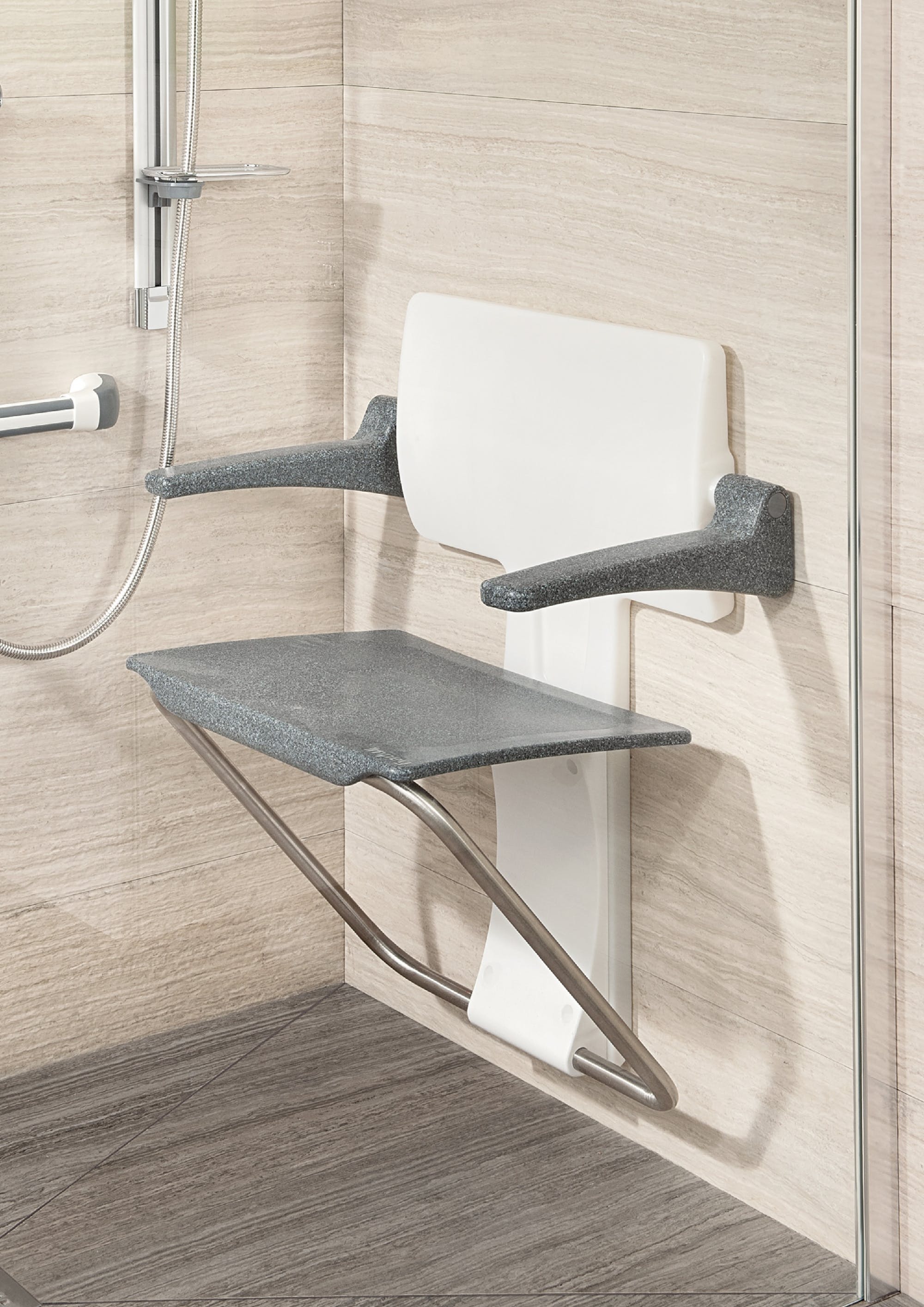
Comfort and dignity
Create a warm and inviting atmosphere
Lighting is also a key factor in creating a dementia-friendly bathroom environment. You can enhance an individual’s visibility and, in the bathroom, get rid of the confusion that could’ve taken place.
Importantly, you’re giving the person with dementia help and the ability to identify their bathroom features and see where they’re going.
As we mentioned, visibility is improved with soft lighting as it does not give any glare or harsh shadows reducing confusion and aiding those who have visual impairments. This is the same with the natural lighting as it provides consistent lighting throughout the bathroom space.
Overall, natural and soft lighting gives a calming atmosphere. If they have a carer, then this makes their job easier as they would as their patient is more likely going to be in a more comfortable and relaxed state.
Comfort and familiarity along with designing a bathroom suited to the person with dementia is instrumental when it comes to designing a dementia-friendly bathroom design.
We’re going to now emphasise the importance of having the right seating in a dementia-friendly bathroom..
Having a seat in the bathroom design can help the individual to do tasks independently this can include things such as dressing and grooming.
In a dementia-friendly bathroom, you can make the individual feel more relaxed and calm. The incorporation of thoughtful artwork and plants that are familiar to the user to increase their comfort. These can activate positive memories and even their well-being.
It will give them a sense of familiarity and security. If you’re thinking of including items such as artwork, plants, and favourite colours, do involve the individual wherever possible in the decision process.
Asking them for their preference and items will hold personal significance to them.
Specific design elements for a dementia-friendly bathroom
Flooring
In this article, we have advised that using nonslip flooring for a dementia user’s bathroom would be the most suitable flooring option due to all of its benefits.
But there are a couple of things you should stay away from when you are thinking of installing new flooring to ensure it is dementia friendly.
Avoid flooring with patterns or speckles as it could confuse individuals with dementia cognitive challenges, and they could mistake it for other items and possibly fall over when they look to try and pick them up.
Furthering this could lead to anxiety and frustration for the individual making it harder for them to use the bathroom individually.
This also reduces the minimalisation of distractions, helping the individual to concentrate on the task at hand.
.jpg?auto=compress%2Cformat&cs=strip&ixlib=php-1.1.0&s=40c0b745fc33efbfb85e816f137be1d8)
Walls
Part of the goal when it comes to a dementia-friendly bathroom is to create an environment where they feel comfortable and can gain familiarity, and most of all, deliver a design that they feel safe in.
Even the walls and their designs have an impact on the user with dementia. Create a less visually distracting bathroom with a more straightforward plain and non-reflective design.
Leaving the walls plain can protect the individual from overstimulation and sensory challenges.
With plain walls, you’re also less likely for them to be misinterpreted, or even confused for other objects.
If you do want to add some colour as part of the design, try going for natural and soft colours these include colours like beige, taupe soft grey, pale blue and much more. They help to create a comforting environment for the individual.
A strong consideration is to use contrasting colours for the walls and different areas of the bathroom, this helps to distinguish between other areas of the room, meaning accessing around for the individual is much easier.
Lighting
We briefly mentioned soft lighting and natural lighting helping a dementia-friendly bathroom design. Alongside natural and soft lighting installation, we are going to delve a bit deeper into other light features that could benefit an individual with dementia.
We think that task lighting can help in areas of the bathroom and shower room design of the dementia-friendly concept.
Task lighting is typically better than ambient lighting and serves a better purpose, as it is created to brighten a certain area allowing focus. This will help those who struggle with focusing better to perform for those specific activities. More importantly, with better concentration, they’ll be able to carry them out effectively.
Task lighting can be especially crucial in the evening. Motion-activated lights can help the individuals at night and prevents them from looking around for the main bathroom light, preventing a potential accident.
Fixtures
Other fixtures that are available to enhance the safety and comfort of the individual with dementia in the bathroom is a raised toilet seat with a grab bar installation.
The individuals who struggle with mobility this can particularly help them as this feature is designed to help to lower and stand them up after use with reduced difficulty. The grab bars are there as additional support and retention of independence.

Storage
Keeping areas in the bathroom well organised and easy to access gives individuals with dementia a simplified decision when they’re going to use items in the storage areas. So you can imagine that this will also reduce frustration occurring, of where items are as they will not have to think as hard to access the items they need, and keeping them organised will just simplify that process for them.
The individuals will be much happier in using the bathroom, as they feel they have more control and independence in an organised familiar environment.
The use of clear containers and labels can help the organised bathroom for the individual as they will be able to access items with clarity.
When you’re placing items that a person with dementia uses, it is better for them to be stored at a comfortable height to prevent any sort of strain or a fall happening if they must over-stretch to reach for items.
Additional tips for creating a dementia-friendly bathroom
Involve the person with dementia in the design process
Involving a person with dementia in the design process can help massively as they will be able to collaborate with the designers and caregivers to get a better understanding of their needs and preferences to help improve their overall daily life in the concept.
The individuals will be able to create habits and routines whilst using the design, having had it tailored to support and enhance the activities that they need to carry them out.
It will give them control and independence back into their lives the best way it can with a recognisable and easy-to-use dementia-friendly bathroom concept.
.JPG?auto=compress%2Cformat&cs=strip&ixlib=php-1.1.0&s=18e0f3e86b4d8e98a9f90b9556d859f3)
Make gradual changes
If a full bathroom refurbishment is off the cards for the time being, then making steady changes over time will help a person with dementia instead of changing the whole concept all at once. This will allow them time to process the changes and get used to them and not overwhelm them.
These can even be with a few simple modifications that can be made like the installation of:
> Grab bars
> Re - organisation of the bathrooom
> Lighting
In need of assistance to create a dementia-friendly bathroom?
Throughout this article we have shown the importance of and how creating a safe, familiar bathroom environment for an individual with dementia can massively help their overall daily life. They will be safe, their independence will be retained, and you reduce the frustration that can occur.
We are experts in delivering peace of mind for those with dementia a bathroom design that will make their lives easier. We have a team of experts who can create a design catered to their needs, whether it is an accessible, mobility or disabled bathroom design. To get in touch, please call or book a free design appointment online.
FAQ's
What are some additional safety measure I can take to prevent falls in the bathroom?
The nice and easy safety measure you can make to prevent falls happening in the bathroom include clearing clutter, and trip hazards off the floor.
Assistance such as canes or walkers will help with the balance and avoid falls in the bathroom.
What are some ways to make my bathroom more accessible for someone with dementia?
Widening the door to the dementia-friendly bathroom can help as it gives wheelchair access, and if they need assistance from a care giver then they will both be able to access the room much easier.
You also reduce the risk of a person to bump into the doors or frames the bathroom.
How can I involve the person with dementia in the design process for their bathroom?
Involving a person with dementia in the design process is crucial as we have mentioned. So asking them for their input or sitting in as part of a design process so they have total control of their bathroom design and what they would like and relay the struggles that they may face.
Showing them pictures of different bathroom designs and asking them questions for feedback will help in the design process.
Finally letting them choose the colours and finishes of the bathroom can hugely help as they will be able to familiarise themselves with it and makes them feel more comfortable.
Share this Post






.jpg?auto=compress%2Cformat&cs=strip&ixlib=php-1.1.0&s=40c0b745fc33efbfb85e816f137be1d8)

.JPG?auto=compress%2Cformat&cs=strip&ixlib=php-1.1.0&s=18e0f3e86b4d8e98a9f90b9556d859f3)
.jpg?auto=compress%2Cformat&cs=strip&fit=clip&h=400&ixlib=php-1.1.0&w=400&s=9fa3862dd64550f902ce5099d00692fb)
